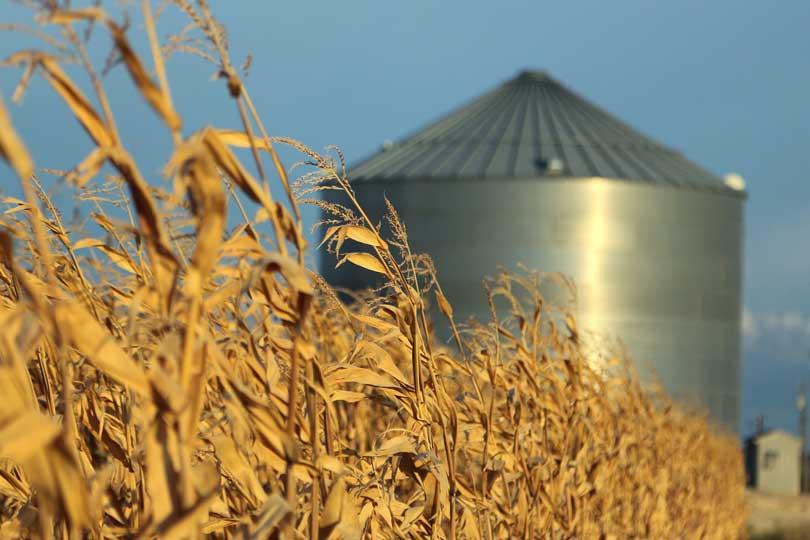By Jessica Domel
Multimedia Report
Trade tensions, drought and higher-than-expected yields have changed the U.S. Department of Agriculture’s (USDA) forecast for many U.S. commodities.
Corn
According to USDA’s World Agricultural Supply and Demand Estimates (WASDE) Report, farmers are forecast to grow more than 14.5 billion bushels of corn this year.
USDA raised its forecast 356 million bushels over the past month after conducting the first yield surveys of the year.
A record 178.4 bushels per acre are forecast. That’s up 4.4 bushels from the July trend-based projection.
Feed and residual use of corn are also up due to the larger crop and lower expected prices.
This year’s corn export forecast was raised this month due to expectations of less competition from Brazil.
U.S. ending stocks were raised 132 million bushels to 1.7 billion bushels as supply is now rising faster than use.
The season average corn price is down 20 cents at the midpoint to $3.10 to $4.10 a bushel.
Soybeans
Higher-than-expected soybean fields prompted USDA to increase its soybean production forecast for this year.
The agency forecasts farmers in the U.S. will grow 4,586 million bushels of soybeans, which is 276 million bushels higher than previous estimates.
USDA’s first survey-based soybean yield forecast for the year reveals an average yield of 51.6 bushels per acre. That’s 2.5 half bushels per acre higher than last year and 3.1 bushels an acre over last month’s forecast.
Soybean supplies for 2018/2019 are now projected at a record 5,040 million bushels.
The U.S. season average soybean price is forecast down 35 cents at the midpoint to $8.90 cents a bushel.
Ending stocks are projected at 785 million bushels, up 205 million bushels from last month’s forecast.
Cotton
Despite a drought crippling much of Texas, the largest cotton-producing state in the nation, USDA still predicts an increase in 2018 cotton production.
In the latest WASDE report, USDA raises its production forecast four percent to 19.2 million bales.
Higher abandonment is expected, but a higher yield average is also expected.
USDA raised beginning stocks to 400,000 bales due to lower than expected 2017/2018 exports and domestic consumption.
Exports for 2018/2019 are forecast 500,000 bales higher at 15.5 million bales.
The marketing year average is forecast at 75 cents per pound.
Wheat
A lower commodity price is expected to lead to lower wheat production in the United States this year.
This month, USDA lowered its wheat production forecast by four million bushels to 1,877 million bushels due to a reduction in winter wheat, durum and other spring wheat.
Meanwhile, USDA increased its projected food use by five million bushels to 970 million bushels.
If realized, that would surpass the previous food use record set in 2017/2018.
The U.S. is forecast to export 1,025 million bushels of wheat this year—an increase of 50 million bushels from last month’s forecast.
USDA attributes substantially lower exportable supplies for the European Union to limited additional export capacity to several other major competitors.
Ending stocks for 2018/2019 are reduced 50 million bushels in this month’s forecast to 935 million bushels. That’s 15 percent lower than last year.
The projected farm season average price is forecast up a dime at the midpoint to $4.60 to $5.60 a bushel.
Grain sorghum
Higher-than-expected yields revealed in the first survey of the season prompted USDA to raise its grain sorghum production forecast for 2018/2019.
Farmers are still expected to plant six million acres, and yield is now expected to average 70.9 bushels an acre. That’s 3.6 bushels an acre higher than in last month’s projection.
Beginning stocks are also forecast higher at 44 million bushels.
Grain sorghum demand is on the rise after the Environmental Protection Agency approved a grain sorghum biofuel pathway, which allows biofuel producers to use grain sorghum oil in their production.
Sorghum use for food, seed and industrial use is also forecast higher.
Rice
Farmers are forecast to produce less rice than previously expected.
This month, USDA lowered its U.S. rice production forecast

